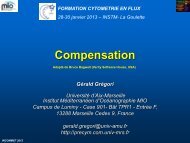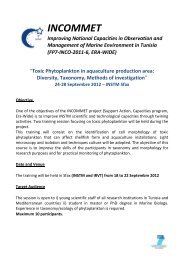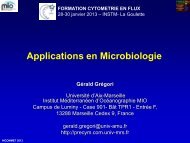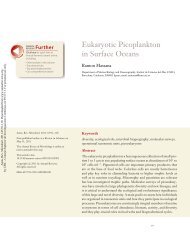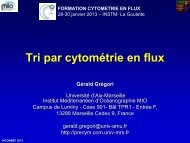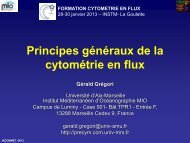Phytoplankton Cell Counting by Flow Cytometry - incommet
Phytoplankton Cell Counting by Flow Cytometry - incommet
Phytoplankton Cell Counting by Flow Cytometry - incommet
Create successful ePaper yourself
Turn your PDF publications into a flip-book with our unique Google optimized e-Paper software.
AAC17 9/24/04 03:47 PM Page 1414 <strong>Phytoplankton</strong> <strong>Cell</strong> <strong>Counting</strong> <strong>by</strong> <strong>Flow</strong> <strong>Cytometry</strong>refractive index for marine particles: comparison with independentand bulk estimates. Appl. Opt. 42:526–41.Hennes, K. P., and Suttle, C. A. 1995. Direct counts of virusesin natural waters and laboratory cultures <strong>by</strong> epifluorescencemicroscopy. Limnol. Oceanogr. 40:1050–5.Jacquet, S., Lennon, J. F., and Vaulot, D. 1998. Application ofa compact automatic sea water sampler to high frequencypicoplankton studies. Aquat. Microb. Ecol. 14:309–14.Lange, M., Guillou, L., Vaulot, D., Simon, N., Amann, R. I.,Ludwig, W., and Medlin, L. K. 1996. Identification of theclass Prymnesiophyceae and the genus Phaeocystis with ribosomalRNA-targeted nucleic acid probes detected <strong>by</strong> flowcytometry. J. Phycol. 32:858–68.Lebaron, P., Parthuisot, N., and Catala, P. 1998. Comparisonof blue nucleic acid dyes for flow cytometric enumerationof bacteria in aquatic systems. Appl. Environ. Microbiol.64:1725–30.Lebaron, P., Servais, P., Agogue, H., Courties, C., and Joux,F. 2001. Does the high nucleic acid content of individualbacterial cells allow us to discriminate between active cellsand inactive cells in aquatic systems? Appl. Environ. Microbiol.67:1775–82.Li, W. K. W., Jellett, J. F., and Dickie, P. M. 1995. The DNAdistributions in planktonic bacteria stained with TOTO orTO-PRO. Limnol. Oceanogr. 40:1485–95.Malara, G., and Sciandra, A. 1991. A multiparameter phytoplanktonculture system driven <strong>by</strong> microcomputer. J. Appl.Phycol. 3:235–41.Marie, D., Vaulot, D., and Partensky, F. 1996. Application ofthe novel nucleic acid dyes YOYO-1, YO-PRO-1, andPicoGreen for flow cytometric analysis of marine prokaryotes.Appl. Environ. Microbiol. 62:1649–55.Marie, D., Partensky, F., Jacquet, S., and Vaulot, D. 1997.Enumeration and cell cycle analysis of natural populationsof marine picoplankton <strong>by</strong> flow cytometry using the nucleicacid stain SYBR Green I. Appl. Environ. Microbiol.63:186–93.Marie, D., Brussaard, C. P. D., Thyrhaug, R., Bratbak, G., andVaulot, D. 1999. Enumeration of marine viruses in cultureand natural samples <strong>by</strong> flow cytometry. Appl. Environ.Microbiol. 65:45–52.Monger, B. C., and Landry, M. R. 1993. <strong>Flow</strong> cytometricanalysis of marine bacteria with Hoechst 33342. Appl.Environ. Microbiol. 59:905–11.Morel, A. 1991. Optics of marine particles and marine optics.In: Demers, S., ed. Particle Analysis in Oceanography.Springer-Verlag, New York, New York, 142–88.Not, F., Simon, N., Biegala, I. C., and Vaulot, D. 2002.Application of fluorescent in situ hybridization coupledwith tyramide signal amplification (FISH-TSA) to assesseukaryotic picoplankton composition. Aquat. Microb. Ecol.28:157–66.Olson, R. J., Frankel, S. L., Chisholm, S. W., and Shapiro, H.M. 1983. An inexpensive flow cytometer for the analysis offluorescence signals in phytoplankton: chlorophyll andDNA distributions. J. Exp. Mar. Biol. Ecol. 68:129–44.Olson, R. J., Vaulot, D., and Chisholm, S. W. 1985. Marinephytoplankton distributions measured using shipboard flowcytometry. Deep-Sea Res. A 32:1273–80.Olson, R. J., Shalapyonok, A., and Sosik, H. M. 2003. Anautomated submersible flow cytometer for analyzing picoandnanophytoplankton: <strong>Flow</strong>Cytobot. Deep-Sea Res. I50:301–15.Partensky, F., Hess, W. R., and Vaulot, D. 1999. Prochlorococcus,a marine photosynthetic prokaryote of global significance.Microb. Mol. Biol. Rev. 63:106–27.Peperzak, L., Vrieling, E. G., Sandee, B., and Rutten, T. 2000.Immuno flow cytometry in marine phytoplankton research.Sci. Mar. 64:165–81.Schönhuber, W., Fuchs, B., Juretschko, S., and Amann, R.1997. Improved sensitivity of whole-cell hybridization<strong>by</strong> the combination of horseradish peroxidase-labeledoligonucleotides and tyramide signal amplification. Appl.Environ. Microbiol. 63:3268–73.Sciandra, A., Lazzara, L., Claustre, H., and Babin, M. 2000.Responses of growth rate, pigment composition and opticalproperties of Cryptomonas sp to light and nitrogen stresses.Mar. Ecol. Prog. Ser. 201:107–20.Sheldon, R., and Parsons, T. 1967. A continuous size spectrumfor particulate matter in the sea. J. Fish. Res. Bd.Canada 24:909–15.Sheldon, R. 1978. Electronic counting. In: Sournia, A., ed.<strong>Phytoplankton</strong> Manual. UNESCO, Paris, France, 202–14.Simon, N., Lebot, N., Marie, D., Partensky, F., and Vaulot, D.1995. Fluorescent in situ hybridization with rRNA-targetedoligonucleotide probes to identify small phytoplankton <strong>by</strong>flow cytometry. Appl. Environ. Microbiol. 61:2506–13.Simon, N., Campbell, L., Ornolfsdottir, E., Groben, R.,Guillou, L., Lange, M., and Medlin, L. K. 2000. Oligonucleotideprobes for the identification of three algal groups<strong>by</strong> dot blot and fluorescent whole-cell hybridization. J. Euk.Microbiol. 47:76–84.Sosik, H. M., Olson, R. J., and Chisholm, S. W. 1989. Chlorophyllfluorescence from single cells: interpretation of flowcytometric signals. Limnol. Oceanogr. 34:1749–61.Trask, B. J., van den Engh, G. J., and Elgerhuizen, J. H. B.W. 1982. Analysis of phytoplankton <strong>by</strong> flow cytometry.<strong>Cytometry</strong> 2:258–64.Vaulot, D., Olson, R. J., and Chisholm, S. W. 1986. Light anddark control of the cell cycle in two phytoplankton species.Exp. <strong>Cell</strong>. Res. 167:38–52.Vaulot, D., Courties, C., and Partensky, F. 1989. A simplemethod to preserve oceanic phytoplankton for flow cytometricanalyses. <strong>Cytometry</strong> 10:629–35.



